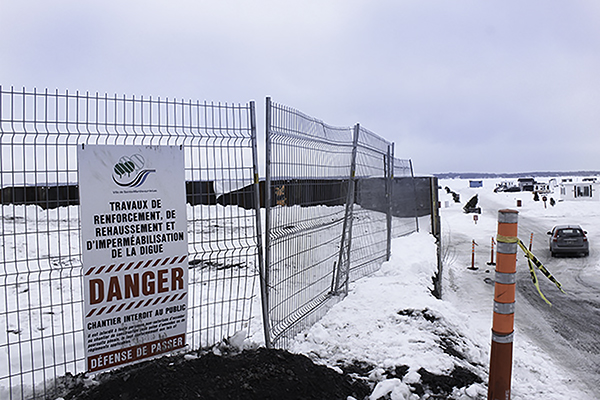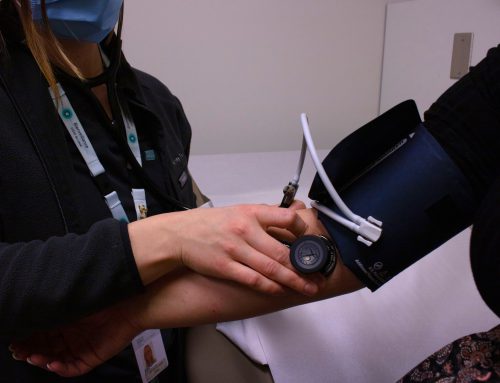BY Geneviève Asselin & Eithne Lynch
Are we ready for the next flood?
France Bernier was flooded out of her St-Anne-de-Bellevue home in 2017. She is preparing for another flood this year. “We know we will have to be there in April,” she says. “We are like prisoners of the basement. We cannot leave, we cannot travel, we have to monitor the water levels.”
She says she and her neighbours went to great lengths to avoid another flood last year. After a local dike broke in 2017 and flooded six homes on Grier Street, they hired an engineer to find out how to better protect themselves from a future flood.
By raising the land’s level, having a strategic dike and pumps working 24 hours a day, the neighbours were able to keep the water out of their homes last year. “The water went up where the dikes were, but the base was much more stable this time”, she says.
Bernier and her neighbours also hired people to monitor the pumps around the clock. Despite the operation being tiring, they will do the same if there is a flood this year.
“Some of the people that live here are more than 70 years old,” says Bernier. “It is exhausting to have to wake up every two hours to make sure the pump is working.”
Three of these six houses affected by flooding are now up for sale. “The risks are getting serious,” says Bernier. “It is part of buyers’ concerns.”
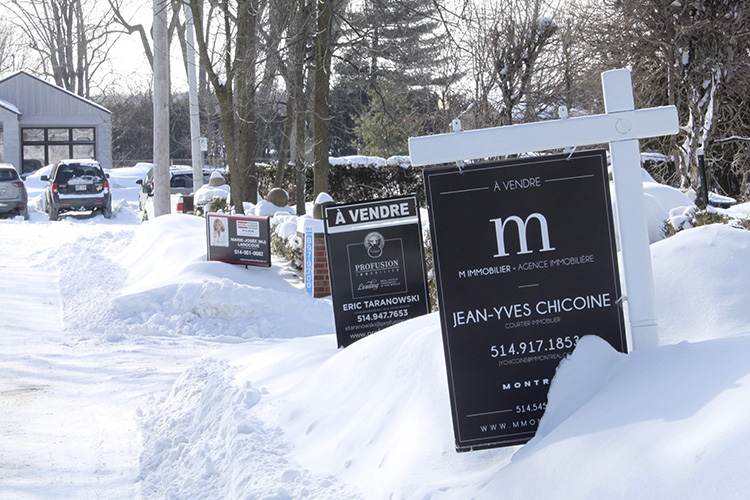
Three homes on Grier Street in Sainte-Anne-de-Bellevue, an area hit hard by flooding, are up for sale. Photo by Eithne Lynch.
In 2019, 20 private residences were flooded, and more than 100 people had to take precautionary measures such as building temporary dikes in St-Anne-de-Bellevue.
Mayor of the city, Paola Hawa, says the city’s emergency operations lasted more than six weeks in 2019 as opposed to just three weeks in 2017. “It’s becoming more and more erratic,” she says. “Last year the water went up and down several times.”
The emergency response is getting better. Cities were able to reduce the number of homes affected by floods from 1,100 in 2017 to 110 homes in 2019.
Danielle Pilette, associate professor in the Department of Strategy, Social and Environmental Responsibility at UQAM, says metropolitan municipalities perform well compared to remote areas because of their level of urbanization and access to the police and fire department.
“The cities that are performing on the emergency level are the ones who organize themselves,” says Pilette, who did her doctorate in urban studies.
In Sainte-Anne-de-Bellevue, the city provides two pallets of sandbags per address for non-permanent dikes. The city is buying more pumps this year as they found it was an effective tool in managing the floods in 2019.
Last year, they were able to contain the water out of the main street by plugging a pump at the entrance of the water purification system. “We had pumps working 24 hours a day, seven days a week,” says Hawa. “Our water purification system alone cannot handle the flow of water due to the huge fluctuations of temperature in the space of 24 hours.”
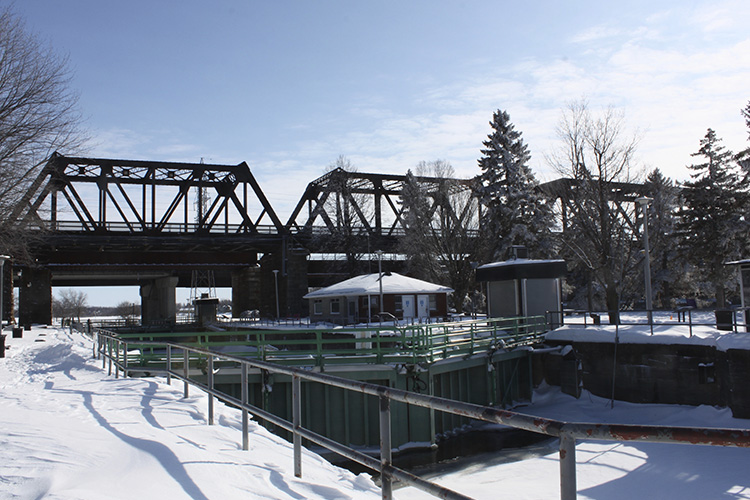
Sainte-Anne-de-Bellevue is at the convergence of several waterways. They are most affected by water from the Lake of Two Mountains water system, according to the mayor. Photo by Eithne Lynch.
This year, Sainte-Anne-de-Bellevue will renaturalize Godin Park near Grier Street, which is one of the areas that floods the most. “When the water hits cement, it has nowhere to go, but up,” says Hawa.
They will demolish the parking lot in Godin Park to create a natural area that will act as a sponge for water. This construction will start this year, but it will be up to three years until it is done.
Side-by-side shot of Godin Park when it was flooded vs. in the February just months away from spring flooding. Photo (Winter) by Eithne Lynch, Photo (flooding) City of Sainte-Anne-de-Bellevue.
Floods cost the city a significant amount of money. The mayor says the emergency operation for each flood costs is close to $250,000 and the adaptation of their park will cost $700,000 over the next two to three years.
Hawa estimates that 50 to 100 volunteers helped residents during the floods, despite the good intentions of people she is worried people’s participation might not last forever.
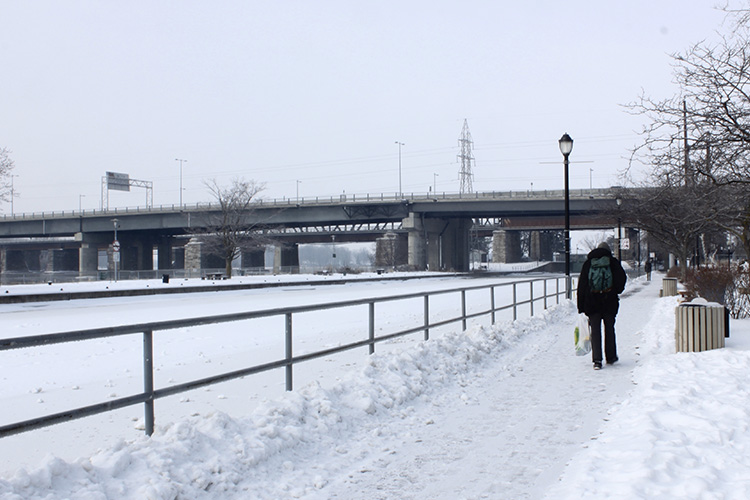
Sainte-Anne-de-Bellevue has two main watersheds that feed into its waterway, the St-Lawrence and Ottawa River. The boardwalk stretches along the water’s edge allowing access to the canal network. Photo by Eithne Lynch.
Lynda Barrett, the executive director of Centre d’action bénévole Ouest-de-l’Île says one notable improvement since the floods is the efficiency of communication on social media and between organizations. “Everybody wants to help, but it is just to canalize that energy in the right directions”, she says.
Pascale Biron, professor and chair of geography, planning and environment department at Concordia University, says the cause of the sudden floods in 2017 and 2019 were a combination of three factors: a lot of snow in the watershed, a rainy spring and frozen soil. “The water was not going in the soil, so it was quickly reaching the river”, says Biron, who specializes in river dynamics and their impact on the land.
Biron says we can expect more and more variations in temperatures which increases the risks of floods, so she says we should plan long-term solutions.
Victoria Blair and her Mother Kim Doucet were evacuated from their home after a dike broke in Sainte-Marthe-sur-le-Lac in 2019.
Biron says Montreal is at higher risk of floods. “Montreal is at the confluence of two big water systems: Ottawa River and St-Lawrence River”, she says. “The volume of water is huge, so storing that water is difficult.”
Hawa says the city has no control over the amount of water they receive from upper streams as this factor is regulated by the federal government and the United States. That body oversees water levels from the Great Lakes in Canada and then decides which dams they open.
“They manage the water to avoid one area from being heavily hit, but that means that we will always get hit, at least in the past few years”, says Hawa.
Bernier says there is a lot of back and forth between the city and the province of Quebec and it is hard to have answers about the neighbourhood’s idea to build a wall to protect their homes as a long-term solution.
“We lack long-term solutions.” says Bernier. “We cannot always rely on volunteers to do non-permanent dikes. We think that our houses still have value, but it seems as if there are not a lot of people who want to help us.”
“Displacing people who live in more remote areas is easier because there are more available sites”, says Pilette. “However, here in Montreal, we cannot displace people elsewhere, because the land is rare. The solution elsewhere practically does not exist.”
City officials of Sainte-Anne-de-Bellevue say that the ideal approach would be to get rid of the infrastructures on the water’s edge which would move the flooding line further from the water’s edge. Yet, as a city Hawa thinks it would be unrealistic to buy out people’s houses. “There is an emotional aspect,” she says. “It is not just a building, it is a home.”
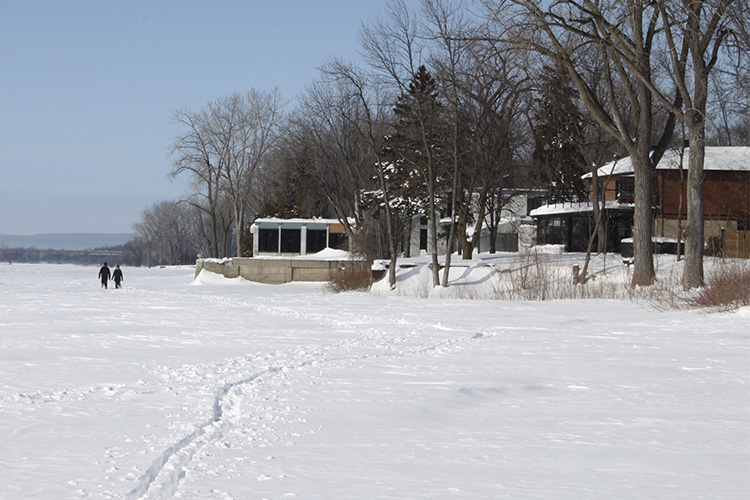
A couple walks on the frozen waters behind homes on Grier street in Sainte-Anne-de-Bellevue. In 2019, residents came together to protect their homes from flooding. Photo by Eithne Lynch.
Biron explains that it is impossible to stop floods. “Floods are a part of rivers’ dynamic,” she says. She encourages cities to preserve wetlands as they are a natural barrier on the shore that prevents water from entering.
She also proposes the creation of recreational parks that would be designed to absorb water when the river overflows. “If no one lives in this area, it is not an issue if the river floods,” she says.
Ryan Young, chairman of the advisory committee on environment in Sainte-Anne-de-Bellevue, says overdevelopment is partially to blame for the current problems.
“We have allowed all kinds of development that should never happened,” says Young. “We destroyed wetlands after wetlands that helps us manage flooding. I hope that one day what we will see is lakeshore reclaimed by nature, and wetlands being put back into place where they were before to avert more flooding.”
“We have to rethink how we allowed this to happen,” says Biron. “We transformed the land by removing wetland. We changed how the water is rooted and it is moving much faster in an urban environment.”
Still waiting for long-term solutions, Bernier and her neighbours will continue to rely on sandbags, pumps and monitoring in order to protect themselves from a possible flood this year.
